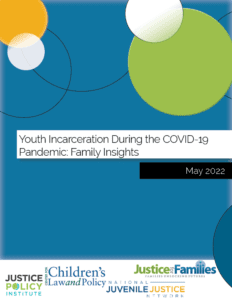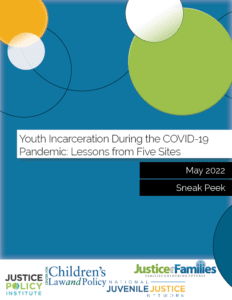 |
On September 23, 2021, a diverse group of parents came together from across the United States to discuss the impact of the COVID-19 pandemic on their justice-involved children. They shared their experiences and critical insights into the realities of the youth justice system during the pandemic, as well as recommendations for improving policy and practice. While the session was broadly framed, many of the participants shared the experience of having a child incarcerated during the pandemic which focused the conversation on that topic.
This document summarizes key findings from the discussion and recommendations for state and local policymakers who want to create safer, healthier environments for justice-involved youth and promote better outcomes for young people, their families, and their communities. |
 |
The COVID-19 pandemic introduced an unprecedented public health crisis impacting nearly every
facet of American life, including the administration of youth justice across the country. As we enter
the third year of the pandemic, it is a critical time to 1) examine smart policy and practice changes
that reduced reliance on incarceration and expanded community-based supports and services for
youth; and 2) translate lessons learned into practical strategies to improve youth justice processes and
promote public safety. An examination of five jurisdictions identified the following effective strategies. This “sneak peek” gives a first look into both strategies that worked and ongoing challenges.In 2020, four national research and advocacy organizations — the Center for Children’s Law and Policy, Justice for Families, the Justice Policy Institute, and the National Juvenile Justice Network — came together to study state and local policy and practice changes that effectively reduced reliance on youth incarceration during the COVID-19 pandemic. The collaborative will release a series of publications that illustrate how agencies across the country can safely reduce reliance on youth incarceration and invest in more effective community-based strategies to support justice-involved youth and families.
This research was funded by the Annie E. Casey Foundation. We thank them for their support but acknowledge that the findings and conclusions presented in this report are those of the author(s) alone, and do not necessarily reflect the opinions of the Foundation. |